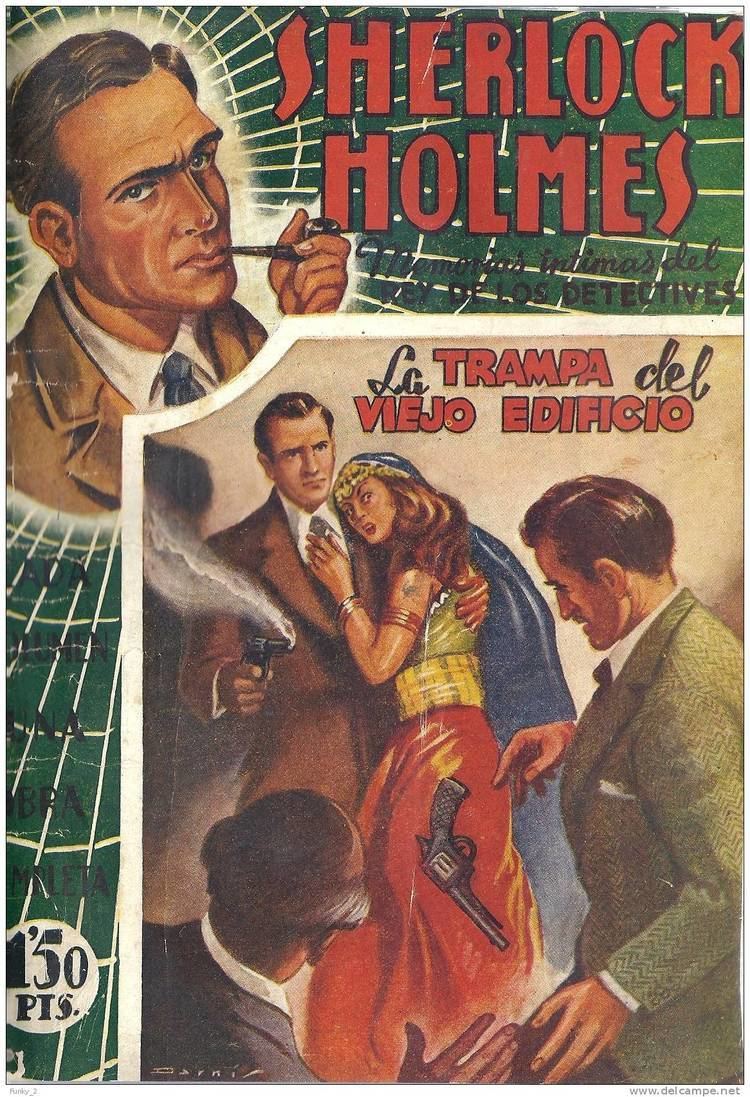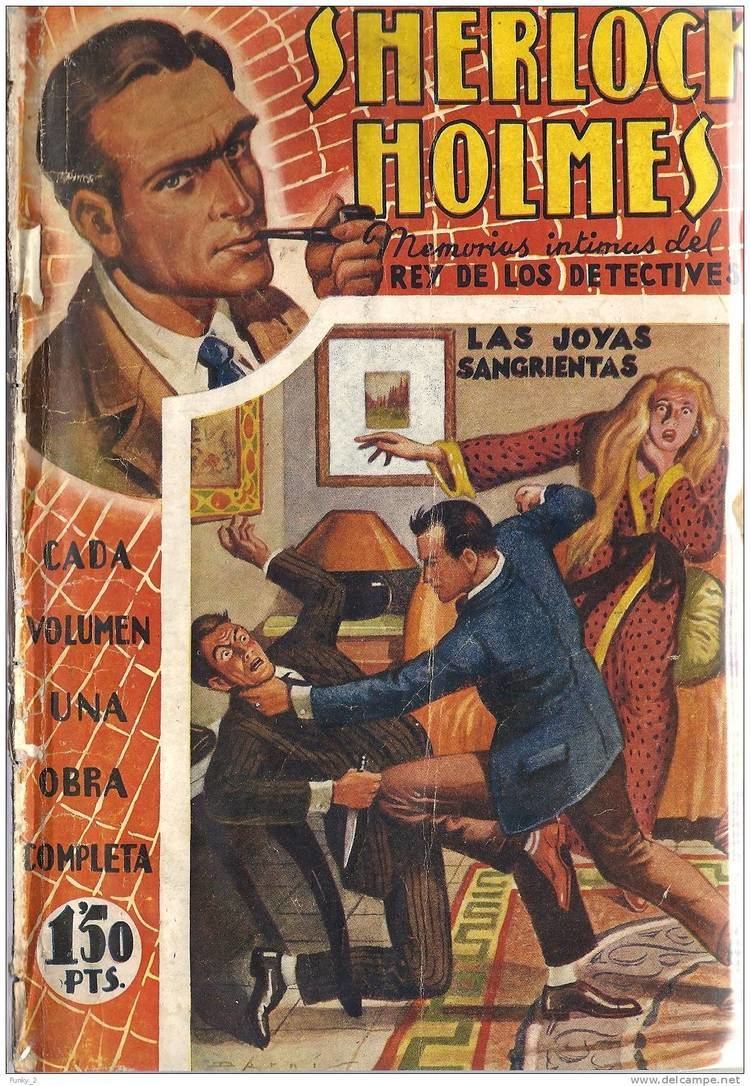 | ||
Similar Carnacki, Jules de Grandin, Sâr Dubnotal, Nyctalope, Doctor Omega | ||
Harry Dickson is a fictional pulp detective, born in America, educated in London, and was called The American Sherlock Holmes. He has appeared in almost 200 pulp magazines published in Germany, the Netherlands, Belgium and France.
Contents
- History
- Overview
- Fictional Biography
- Pastiches
- Published by Dargaud
- Published by Soleil
- Others
- Literature
- References

History

The original pulp dime-novel series that later became Harry Dickson began in Germany in January 1907 under the title of Detective Sherlock Holmes und seine weltberühmten abenteuer (Sherlock Holmes' Most Famous Cases), published by Verlagshaus für Volksliteratur und Kunst, and comprised 230 issues in total, published until June 1911. The name Sherlock Holmes was actually used for the first 10 issues. After some concern about the rights of Sir Arthur Conan Doyle, the series was retitled Aus dem Geheimakten des Weltdetektivs (The Secret Files of the King of Detectives) with No. 11, even though the main character was still called Sherlock Holmes inside. Holmes' Doctor Watson sidekick, however, was a younger man named Harry Taxon.

Sixteen issues of the original German series were adapted into French starting in October 1907 by publisher Fernand Laven for the magazine La Nouvelle Populaire under the title Les Dossiers Secrets de Sherlock Holmes (Sherlock Holmes' Secret Files) for No. 1, immediately changed to Les Dossiers Secrets du Roi des Détectives (The Secret Files of the King of Detectives) with issue No. 2.

In December 1927, the Dutch-Flemish publisher Roman-Boek-en-Kunsthandel launched a Dutch translation of the original German series, this time entitled Harry Dickson de Amerikaansche Sherlock Holmes (Harry Dickson, the American Sherlock Holmes).
The name Harry Dickson may have been inspired by that of Harry Taxon (from the German edition above), or by writer Arnould Galopin's Allan Dickson, the King of Australian Detectives which had been created in the early 1900s. Allan Dickson even met Sherlock Holmes in L'Homme au Complet Gris (The Man in Grey) (1912).
The Dutch series lasted 180 issues, until May 1935. In it, Dickson's young assistant was renamed Tom Wills
In 1928, Belgian publisher Hip Janssens asked writer Jean Ray to translate the Dutch series into French, for distribution in Belgium and France. The French-language edition, also entitled Harry Dickson, le Sherlock Holmes Americain, began in January 1929.
Eventually, Ray became tired of translating the mediocre original stories. Using the titles and the covers from the original pre-World War I German edition (by artist Alfred Roloff, a member of the Berlin Academy) as starting points, he began to write his own stories. The French edition lasted 178 issues, until April 1938.
Overview
The adventures of Harry Dickson and his young assistant, Tom Wills, have delighted several generations of French readers. Because they were written by a master of horror fiction, they are far more fantasy-oriented than the true Holmesian canon. The best and most fondly remembered Harry Dickson stories are those that pit the Great Detective against some supervillains such as Professor Flax, the mad scientist known as the Human Monster, and, later, his daughter, the equally deadly Georgette Cuvelier, a.k.a. The Spider (with whom Dickson had a love-hate relationship); Euryale Ellis, a beautiful woman who had the power to turn her victims into stone and who may be a reincarnation of the legendary gorgon Medusa; Gurrhu, a living Aztec god who hid in the Temple of Iron, an underground temple located beneath the very heart of London, filled with scientifically advanced devices; the last, living Babylonian mummies who found refuge under a Scottish lake; a nefarious blood-drinking serial killer dubbed the Vampire with Red Eyes; the enigmatic, tuxedo-suited avenger known as Cric-Croc, the Walking Dead; the supervillain Mysteras, who relies on elaborate and deadly illusions; the bloodthirsty Hindu god Hanuman, etc.
Harry Dickson's fame in France rivals that of Sherlock Holmes and Arsène Lupin.
Fictional Biography
Based on various clues mentioned in the series, Harry Dickson was likely born circa 1890 in New York City. He was educated from childhood in England, because his father wanted him to receive a British education. He only spent three months during his summer holidays in New York where, as a child, he befriended Reginald Marlow.
Dickson’s family background is unknown, but we know that Arsène Lupin studied magic with a stage magician named Dickson in Paris in 1893.
At age 15, Dickson was a student in England at the Pertwee Private School and solved a case involving a diamond smuggling ring. At age 20 or about, Dickson enrolled as a student at the University of South Kensington in London and became acquainted with Jean Ray’s armchair detective Mister Triggs. He also helped fellow French student Antoine de Hautefeuille solve a family mystery.
Coincidentally, Arnould Galopin began recording the adventures of a young detective named Allan Dickson also in 1910 although Galopin’s Dickson is said to be Australian.
In 1919, Dickson was on an official intelligence mission in post-war Berlin. There, he met the brilliant Professor Krausse, whom he much impressed. Dickson met Krausse again, ten years later, i.e.: in 1929, when he was already an established detective at 221B Baker Street. This supports the motion that Dickson’s published cases take place from the mid-1920s to the mid- or late 1930s when he was in his late thirties and early forties, which is consistent with his physical description and abilities.
Pastiches
Published by Dargaud
Free adaptations written by Christian Vanderhaeghe; drawn by Pascal J. Zanon.
- La Bande de l'Araignée (1986)
- Les Spectres Bourreaux (1988)
- Les Trois Cercles de l'Épouvante (1990)
- Le Royaume Introuvable (1994)
- L'Étrange Lueur Verte (1997)
- La Conspiration Fantastique (1999)
- Echec au Roi (2002)
- Le Temple de Fer (2003)
Published by Soleil
New stories written by Richard Nolane; drawn by Olivier Roman.
- L'île des Possédés (1992)
- Le Démon de Whitechapel (1994)
- Les Amis de l'Enfer (1995)
- L'Ombre de Blackfield (1996)
- La Nuit du Météore (1998)
- La Terreur Jaune (2000)
- Les Loups de Darkhenge (2001)
- Le Sanctuaire du Grand Ancien (2002)
- Le Secret de Raspoutine (2003)
- La Sorciere du Kent (2004)
- Le diable du Devonshire (2008)
- Le semeur d'angoisse (2005)
- L'héritage maudit de Rennes-le-Château (2009, 2014)
Others
Filmmaker Alain Resnais tried, unsuccessfully, to get a live-action Harry Dickson feature off the ground in the 1960s. The script has been published in a book title "Les aventures de Harry Dickson, scénario pour un film (non-réalisé) par Alain Resnais de Frédéric Towarnicki" - Capricci Editions - Paris décembre 2007
